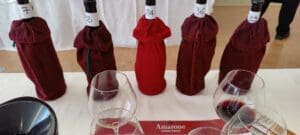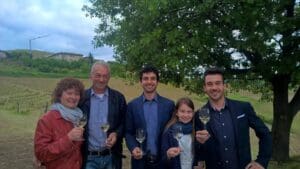Arrived with a pair of sleepy eyes and sore butt, I stood in Palazzo Gran Guardia expecting to pit my taste buds against a hundred wines. To taste all wines was a foolish idea which I did not entertain. As I stumbled through the halls amidst the buzzing of foreign greetings and seeing how television journalists caught unsuspecting guests for interviews, I finally found a spot where I could comfortably see and savour away from the chaos. Heaven’s will, perhaps, that I am to start with one of the greatest wines in the north. And so by chance, I found myself standing before two rows of Barolo producers on both sides.
It was only a few Mondays before the trip when I turned up at Garibaldi restaurant on the invite of Berry Bros & Rudd, a media lunch with Davide Rosso representing Azienda Agricola Giovanni Rosso. A rainy day leading the work week did not dampen our mood, and neither our thirst for some Barolo.
On entering the private chamber, it wasn’t difficult to spot four bottles of Barolo at a corner already uncorked and almost emptied. Poured, exposed and aerated in their decanters were bottles from 2008 and 2009. We were here to commit infanticide on these wines, and there was no way they would get past our mouth without a fierce display of harsh tannins. Or so I thought.
Again, I was wrong. Generous amount of tannins that were nowhere harsh. One silky, velvety, then some firm and dense, all from wines that were way before puberty.
This represents a trend took up by many producers who want to make their wines approachable early. Typically this is achieved by reducing the overall tannins level by limiting the skin contact during fermentation, since Nebbiolo is already a tannin rich variety. Choosing French oak over Slavonian oak to impart popular oak aromas. And lastly adopting a smaller vessel that encourages oxygenation during barrel ageing to promote softening of tannins further. And the result from these changes implies the ten years wait may no longer be applicable, a minimal duration traditionalists often swear by.
Moving the stage back to Opera Wines tasting. Eight Barolo, barely ready for the market, were tasted and they spread across a spectrum of varying strength. 2009 Pio Cesare Ornato Barolo and 2009 Prunotto Bussia Barolo used French oak barrels in their production, and both delivered a very welcoming silky texture which prompted me to place more attention on aromas.
Other producers such as Vietti, Mascarello and Aldo Conterno were on the direct opposite camp. The 2010 Vietti Lazzarito can be explained as exuberance of raw flavours, like freshly bottled from the barrel with a pronounced grip on the palate which it wasn’t shy to prove. The other less friendly wine was Mascarello Riserva 2006 Barolo from the Monprivato vineyard. Grainy texture and appeared to be closed when tasted. Finally the raw prowess of Aldo Conterno 2010 “Cicala” Barolo was too obvious to be ignored.
I am not here to sing the merits of either camp, but I find it immensely beneficial to find producers who are looking to please impatient drinkers like myself. For people who are willing to hold wines in place where the sun doesn’t shine, these traditionally brazen Barolo continue to be a good option that will reward those who wait. Even though I wouldn’t drink Aldo Conterno “Cicala” today, the balance brought on by pinpoint precision in the structure left an etching impression. Assuming ceteris paribus, the balance today will be extraordinary in its prime.
Let the torches of traditionalists continue to burn and them condemning modernists as heretics. Ultimately the market has an appetite ready for wines from either camp. It is better a market with diverse taste preferences than a homogeneous one. For the greatest wines are said to replicate their land, and so they will be heterogeneous after all.



